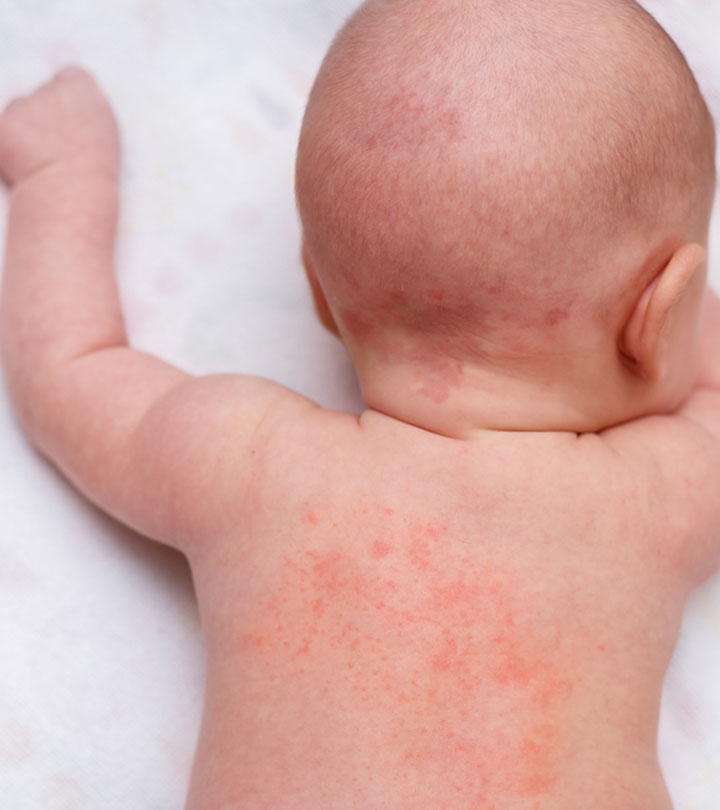Heat rashes affect about 40 percent of newborns, mostly in the first month of their lives (1). A baby’s heat rash is often due to underdeveloped sweat glands. However, in some cases, heat rashes may occur due to the blockage and inflammation of sweat glands or overheating. In either case, these rashes can be treated with home remedies after consulting a pediatrician.
Read about the types, symptoms, risk factors, treatment, and prevention of a heat rash in babies.
Types Of Heat Rashes In Babies
Heat rashes, also known as prickly heat or miliaria, can be of different types, depending on the location of the skin rash, its clinical features, and other factors, such as the baby’s age (2) (3) (4).
- Miliaria crystallina: This sub-type of heat rash is commonly seen in the neck, trunk, and head areas. Miliaria crystallina mostly affects babies aged two weeks or less and is caused due to the obstruction of the sweat gland duct right beneath the skin’s surface (in the stratum corneum of epidermis).
- Miliaria rubra: It is the most common type of heat rash that might be seen in babies between one and three weeks of age. It is caused due to the blockage of the sweat gland duct present in the deeper layers of the skin (below stratum corneum).
- Miliaria profunda: This form of heat rash happens due to the blockage of sweat gland ducts at the junction of epidermis and dermis, the deepest layer of skin. This is the rarest form of miliaria, and it seldom occurs in babies.
Symptoms Of Heat Rash In Babies
Babies experiencing heat rashes may encounter the following symptoms (5) (6).
- Skin redness accompanied by small bumps (miliaria rubra)
- Severe itching
- Prickling or slight burning sensation
- Watery blisters (miliaria crystallina)
- Swelling around the rashes
- Formation of pustules (miliaria pustulosa)
The most common areas where heat rashes occur are skin folds, such as neck folds and skin folds in the diaper area.
Treatment For Heat Rash In Babies
Miliaria crystallina usually go away within a day with no treatment. Medicinal creams or ointments are not usually recommended for the treatment of heat rashes in babies. Miliaria rubra may require application of topical steroid and miliaria pustulosa may require the application of topical antibiotics, if advised by a doctor. You may consider the following steps to reduce the intensity of the rashes and alleviate any irritation or discomfort (5).
- Cool the skin using a cloth dipped in cold water (cold compress).
- Dress your infant in light clothing.
- Clean the sweat in skin folds and ensure that they remain dry.
- Keep your baby cool with the help of an air conditioner or a fan.
- Treat febrile illnesses.
A mother of three who also maintains a blog has shared her experience dealing with her son’s heat rash. She reflects, “My son had prickly heat rash. We live in a desert, and it was 105 degrees the day he was born. I was putting too many clothes on him and keeping him swaddled with a blanket and a hat on him. His immature skin had pores that got clogged easily, and he had very sensitive skin. His rash resolved within hours by keeping him out of clothes, keeping him cool, and taking him into lukewarm baths with me. To this day he still sweats a lot but doesn’t get rashes anymore from sweating (i).”
Prevention Of Heat Rash In Babies
Rashes are commonly caused due to the sweat blocked inside the skin layers. You may prevent this from happening with the following interventions.
- Do not overdress your baby in extra heavy layers of clothing, and tight clothing, as it can block the sweat glands.
- Keep the indoors cool.
- Do not put ointments, powders for oily creams, or oil on your baby’s skin or scalp as they block the skin’s pores.
- Make sure the skin folds near the neck or other body parts are clean and dry.
- Ensure adequate ventilation in the baby’s room.
When To Call The Doctor
Heat rashes usually get better on their own within 24 hours. However, contact your baby’s pediatrician if the inflamed skin persists, the rashes become enlarged, tender, and show no signs of healing after a few days. Other symptoms to look out for are (7):
- Pus in the rash
- Fever
- Swelling of the lymph nodes near the armpit or neck
- Pain and swelling surrounding the areas affected by the rash
- Constant fussiness
- Irritation interferes with the baby’s sleep and appetite
Heat rashes are commonly seen in babies during hot and humid weather. They usually go away on their own within a few days without the need for medical attention. However, if the rashes persist for more than a few days, it is advised to consult your child’s pediatrician. Dressing up your baby in light and breezy clothes may help reduce the chances of heat rash.
Key Pointers
- Underdeveloped sweat glands may cause heat rashes in babies.
- Itching, red bumps and swelling, and water blisters are a few symptoms to look for.
- Cleaning the skin folds, keeping the baby dry and cool, and using a cold compress could help treat heat rashes in babies.













